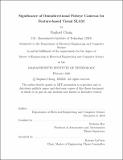| dc.contributor.advisor | Nicholas Roy. | en_US |
| dc.contributor.author | Chang, Raphael,M. Eng.Massachusetts Institute of Technology. | en_US |
| dc.contributor.other | Massachusetts Institute of Technology. Department of Electrical Engineering and Computer Science. | en_US |
| dc.date.accessioned | 2021-02-19T20:38:45Z | |
| dc.date.available | 2021-02-19T20:38:45Z | |
| dc.date.copyright | 2020 | en_US |
| dc.date.issued | 2020 | en_US |
| dc.identifier.uri | https://hdl.handle.net/1721.1/129885 | |
| dc.description | Thesis: M. Eng., Massachusetts Institute of Technology, Department of Electrical Engineering and Computer Science, February, 2020 | en_US |
| dc.description | Cataloged from student-submitted PDF of thesis. | en_US |
| dc.description | Includes bibliographical references (pages 117-124). | en_US |
| dc.description.abstract | Robust GPS-denied navigation of mobile robots is becoming increasingly important as robots become more ubiquitous. Cameras are powerful sensors for this application due to their low cost and high information density. The task of using camera-based computer vision techniques for navigation is typically referred to as visual simultaneous localization and mapping (SLAM), where a robot both estimates its pose and reconstructs its environment simultaneously using only cameras. Most existing work for visual SLAM relies on the use of the pinhole camera model, which requires that images from wider angle, more distorted lenses be rectified before they are usable. This limits the field of view well below 180 degrees. However, cameras with omnidirectional fisheye lenses can see much more of their surroundings, which suggests they may be beneficial for the visual SLAM task; this hypothesis is supported by the trend that recent commercial products that rely on robust visual navigation use fisheye cameras. In this thesis, we explore the apparent discrepancy between the types of cameras traditionally used for navigation tasks in the research community and in industry where robustness is critical. We propose that the scarcity of work using omnidirectional cameras is due to an ill-formed belief that adapting fisheye lenses into traditional computer vision algorithms is infeasible or not worth the effort required to redesign those algorithms. To show this, a benchmarking suite for stereo visual SLAM was developed using traditional feature-based visual odometry algorithms. The building block components of visual SLAM, including feature correspondence, odometry, and reconstruction, were evaluated for both fisheye and perspective cameras. The results show that not only do omnidirectional fisheye cameras easily plug into existing algorithms with minimal modification, they also result in better performance for navigation tasks than perspective cameras with limited field of view. | en_US |
| dc.description.statementofresponsibility | by Raphael Chang. | en_US |
| dc.format.extent | 124 pages | en_US |
| dc.language.iso | eng | en_US |
| dc.publisher | Massachusetts Institute of Technology | en_US |
| dc.rights | MIT theses may be protected by copyright. Please reuse MIT thesis content according to the MIT Libraries Permissions Policy, which is available through the URL provided. | en_US |
| dc.rights.uri | http://dspace.mit.edu/handle/1721.1/7582 | en_US |
| dc.subject | Electrical Engineering and Computer Science. | en_US |
| dc.title | Significance of omnidirectional fisheye cameras for feature-based visual SLAM | en_US |
| dc.type | Thesis | en_US |
| dc.description.degree | M. Eng. | en_US |
| dc.contributor.department | Massachusetts Institute of Technology. Department of Electrical Engineering and Computer Science | en_US |
| dc.identifier.oclc | 1237280831 | en_US |
| dc.description.collection | M.Eng. Massachusetts Institute of Technology, Department of Electrical Engineering and Computer Science | en_US |
| dspace.imported | 2021-02-19T20:38:15Z | en_US |
| mit.thesis.degree | Master | en_US |
| mit.thesis.department | EECS | en_US |
